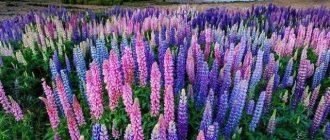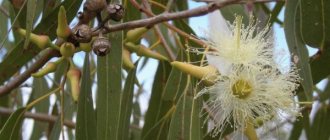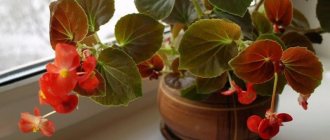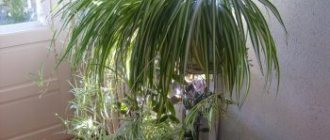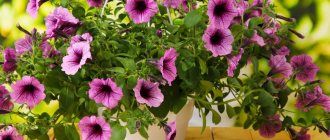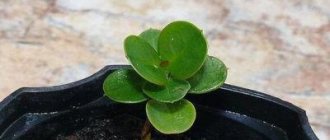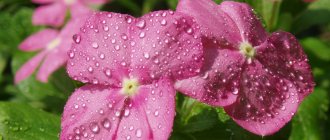Begonia is a large genus of annual and perennial plants, numbering more than 1000 varieties. The plant stands out among other ornamental crops due to its long flowering, varied colors and unusual shape of leaf blades. The flower is capable of propagation by leaves, cuttings, tubers, air layering, dividing the bush and seeds.
However, it is recommended to propagate long-flowering species using seeds; this will preserve the purity of the variety and ensure long-term flowering of future plants. Growing begonia from seeds is a rather labor-intensive and time-consuming process, but at home it is the most effective and productive. If you follow the basic recommendations of agricultural technology, even an inexperienced but attentive gardener can grow a healthy plant.
Brief information about the plant
Begonia is a perennial or annual plant that belongs to the Begoniaceae family. There are 1,600 varieties of culture, each of which has its own characteristics.
Begonia was first discovered by Charles Plumier, who took part in an expedition organized by Michel Begon in 1687. In 1690, C. Plumier named the new genus “begonia” in honor of his friend Michel Begon.
The flower's homeland is South America, West Africa, Central and Southeast Asia. It grows naturally in the tropics; when grown at home, a humidity level of at least 60% should be maintained. Ever-flowering varieties and tuberous varieties, which can be planted in open ground in the summer, are very popular.
Sowing time
To grow seedlings, you must adhere to certain sowing dates. Begonia requires a lot of light, and planting too early can result in a weak crop.
Regions
The crop has a long growing season, so to obtain seedlings, seeds are usually planted somewhat earlier than other flowers.
- Southern regions - seeds are planted at the end of January.
- Northern regions - in the Urals and Siberia, seeds are sown in mid-March.
- Leningrad region - in early March.
- The middle zone is in early February.
Moon calendar
Climate features make it possible to determine the period of sowing in different regions. Specific dates for sowing begonia seedlings are helped by choosing the lunar calendar, which determines favorable and unsuitable days in the desired month.
You should not sow on the days of the full moon and new moon. The most productive days for sowing are the days during the waxing Moon, but during the waning Moon you can also carry out sowing work.
Existing methods of propagation of begonia
The varietal diversity of begonias can amaze even an experienced gardener. So, in total there are about two thousand varieties of this plant, among which you can find specimens:
- annuals;
- perennial;
- evergreen;
- decorative flowering or deciduous;
- deciduous;
- rhizomatous and other varieties.
Not only are you free to choose any variety that interests you, suitable according to the desired parameters, but initially you can also determine the method in which you want to propagate this or that plant.
There are many different methods of propagating begonias that you can use, however, the most preferable is growing seedlings from seeds, since this method is highly productive
So, the most common breeding methods are:
- rooting cuttings obtained from begonia;
- tuberous division;
- growing a plant from a torn leaf plate or part of a leaf;
- dividing an adult begonia bush;
- growing seedlings from seeds.
If you are an inexperienced gardener, then the easiest way for you to grow begonia for the first time is from a tuber divided into several segments, or by cuttings, since both of these methods practically do not involve any subtleties or difficulties.
However, these simplified techniques have one caveat: they are unable to provide you with a large number of seedlings at a time, therefore, if you need to plant a large area with begonias, and you do not know how to select large quantities of material suitable for propagating begonias vegetatively, it is best for you pay attention to the sowing method of growing this plant.
Begonia seeds are sold everywhere, in the form of granules, which are very convenient to sow in the ground.
The generative method of breeding begonias, of course, is much longer and, of course, labor-intensive, however, it is this method that can show the greatest productivity.
In order for the propagation of begonia using seeds to be successful, it is necessary to follow some rules, which we discuss below in the article.
Prices for begonia seeds
begonia seeds
Preparing for sowing
In order for planting material to sprout well, not only the soil, but also the planting container should be properly prepared.
Seed selection
Begonia seeds are very small and difficult to process before planting, so this procedure is not carried out.
You can buy granulated seeds at a gardening store; they are much larger and easier to sow.
Soil selection
To grow begonia seedlings at home, you need light, breathable soil. You can choose a ready-made substrate designed specifically for begonias.
You can also make your own soil mixture. To do this, use garden soil, peat, humus and sand in a ratio of 2:2:1:1. Mix everything thoroughly and place on a baking sheet, which must first be covered with baking paper. Fry the soil for 15-20 minutes in the oven at a temperature of 70℃ (instead of heat treatment, the mixture can be spilled with a light pink solution of potassium permanganate).
Selection of capacity
To grow begonias, you can use special containers for seedlings or transparent food containers. In the latter option, be sure to make drainage holes before filling with soil. The optimal height of the container is 10 cm, the width varies depending on the number of seeds.
Before planting the planting material, the containers should be treated with boiling water. This technique eliminates possible fungi and protects the plant from diseases.
Diseases and pests
By following all the rules for growing begonia from seeds, you can significantly reduce the risk of seedling disease. However, you need to be aware of possible problems in order to see them in time and take the necessary measures. When growing begonia from seeds, the following diseases and pests may appear:
- Root rot, to get rid of this problem it is necessary to ventilate the greenhouse more often and reduce watering.
- Powdery mildew.
- Aphids and spider mites are controlled with insecticides and fungicides.
Sowing work - step-by-step instructions
Begonia pleases with its flowering throughout the summer until autumn. Propagation by seeds allows you to get a flowering bush in 6 months if all care conditions are met. Step-by-step instructions for sowing seeds:
- A layer of drainage up to 2 cm thick is placed at the bottom of the prepared container for planting. Fine expanded clay is usually used as a drainage material.
- Fill the container with soil mixture, leaving 2 cm at the top so that you can make a greenhouse.
- The soil is moistened with warm water using a spray bottle and left for 20-30 minutes.
- Using tweezers (or a sheet of paper folded in half), distribute the seeds at a distance of 2-3 cm from each other. To make seedlings appear faster, the seeds are not sprinkled with soil on top.
- Cover with plastic film or glass to create a greenhouse effect.
- The container is placed on the windowsill and the temperature is maintained at at least +23℃.
The greenhouse is opened slightly for 30 minutes every day to prevent the seeds from becoming moldy. During the ventilation process, condensation is removed and, if necessary, the soil is moistened. After the first shoots appear, the greenhouse is opened.
If peat tablets are used, planting is carried out according to the following scheme:
- The tablets are placed on a tray 5-10 cm high and watered.
- The material is left in this form for several hours until it swells.
- One seed is placed in each peat puck. For ease of sowing, pelleted seeds are usually used. They are covered with a special shell, since in its natural form a begonia seed looks like a speck of dust.
- Moisten with warm, settled water and cover the tray with film or glass.
Caring for crops in peat tablets is the same as when planting in the ground. The only difference is that you can water the peat washers through a tray. The material absorbs the required amount of liquid well.
Seed selection
To grow beautiful and healthy plants, you need to choose high-quality seed material. When choosing them, you should consider the following:
- Packaging time. It is recommended to choose fresh seeds that were collected this year. The longer the seeds are, the less similar they will be, even if the expiration date indicated on the package has not yet expired.
- It is more convenient to plant granulated seeds in peat tablets. They have a dense coating of nutrients that make the seeds larger.
- It is more convenient to sow simple seeds in containers or seedling boxes.
When will the shoots appear?
Planting material sprouts in 10-14 days. However, in some cases, sprouts do not appear for 3-4 weeks, so there is no need to stop care.
Sometimes shoots appear after 5-6 days and the sprouts freeze in growth. This is considered a normal process for begonias and does not require intervention.
After the first shoots appear, the covering material is removed, otherwise the seedlings may get burned and die.
Conditions for growing seedlings at home
As a rule, seedlings appear together. After sprouts appear, it is very important to take proper care. Plants are very sensitive to changes in temperature and humidity levels.
For growing begonia seedlings, the optimal temperature is +21-23 ℃. When the second true leaf appears, the temperature can be reduced to +18 ℃, but no more. Otherwise, the leaves will begin to turn yellow and the crop will die.
The plant prefers a high level of humidity, so moistening is carried out as the top layer of soil dries. To water the seedlings, use a syringe or spray bottle so as not to harm the delicate sprouts. Water the seedlings with warm, settled water.
What affects germination
Begonia does not germinate for the following reasons:
- Old seed – flower seeds can be stored for 1-3 years, so it is better to sow seeds collected last year.
- Substrate drying out - peat should always be moist; if it dries out, it will be difficult to wet it again.
- Temperature below +25° C - it is necessary to maintain the desired temperature in the room, if necessary, use additional heaters.
- Dry air – the air in the room should have normal humidity. If it is so dry and hot, it is recommended to spray the plant with water from a spray bottle or install automatic air humidifiers.
Picking - step by step instructions
Picking is necessary so that the begonia seedlings form a strong root system and are transplanted into open ground. For begonias, experienced gardeners carry out 2 picks. The first procedure should begin after the plant has formed its third true leaf. Step-by-step instruction:
- The container with the seedlings is moistened and left for 2 hours so that the water is completely absorbed and the roots are not damaged during the transplantation process.
- Drainage holes are made in new containers if they are missing.
- A drainage layer 3 cm thick is laid on the bottom.
- Fill the container with the soil that was used for planting the seeds and make a hole.
- Using a wooden spatula, carefully separate the sprout along with a lump of soil and transplant it into a new container.
- Compact the soil around the seedling with your fingers and water with warm water.
- The containers are placed on a tray to collect excess liquid during watering and placed on the windowsill.
After the begonia seedlings are planted, in the first 2 days the container with the glasses is slightly shaded so that the begonia can more easily withstand stress. Water the plants after the soil dries. Add moisture to the root using a syringe so that drops of water do not fall on the leaves.
The second picking is carried out 1 month after the first. Step-by-step instruction:
- Take new containers with a diameter of no more than 15 cm and treat them with boiling water or a solution of potassium permanganate.
- A drainage layer of expanded clay or coarse sand is placed at the bottom.
- Fill with the substrate that was used previously.
- Using the transfer method, begonia seedlings are moved to a new container.
The containers are placed in a well-lit place and slightly shaded with paper from direct sunlight.
10 days after the second picking, fertilizing is carried out with complex fertilizers: Agrecol or Helprost.
Hardening
Hardening of seedlings is a procedure that allows you to prepare a plant for transplanting into open ground. They begin to harden begonia 1 month before planting in open ground.
First, open the window for 20-30 minutes a day and ventilate the room with the sprouts. Gradually the duration of the procedure is increased to a whole day. In spring, when the air temperature warms up to +14 ℃, the crop is taken out onto the balcony or street. This hardening strengthens the begonia and helps increase immunity before a sharp change in temperature.

